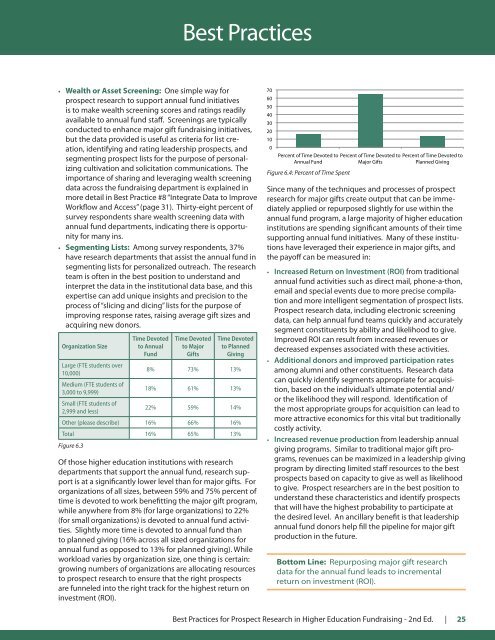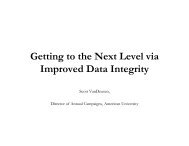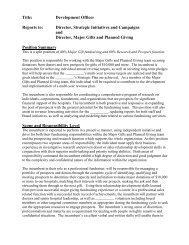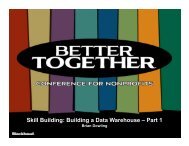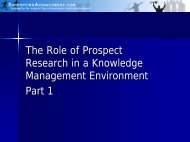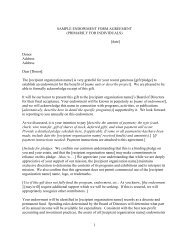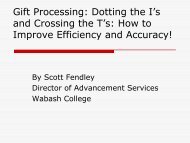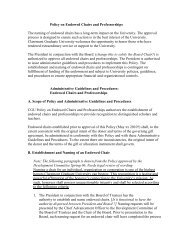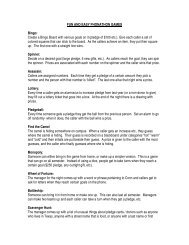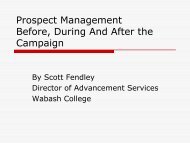WealthEngine Best Practices in Higher Education for Prospect ...
WealthEngine Best Practices in Higher Education for Prospect ...
WealthEngine Best Practices in Higher Education for Prospect ...
Create successful ePaper yourself
Turn your PDF publications into a flip-book with our unique Google optimized e-Paper software.
<strong>Best</strong> <strong>Practices</strong><br />
Wealth or Asset Screen<strong>in</strong>g: One simple way <strong>for</strong><br />
prospect research to support annual fund <strong>in</strong>itiatives<br />
is to make wealth screen<strong>in</strong>g scores and rat<strong>in</strong>gs readily<br />
available to annual fund staff. Screen<strong>in</strong>gs are typically<br />
conducted to enhance major gift fundrais<strong>in</strong>g <strong>in</strong>itiatives,<br />
but the data provided is useful as criteria <strong>for</strong> list creation,<br />
identify<strong>in</strong>g and rat<strong>in</strong>g leadership prospects, and<br />
segment<strong>in</strong>g prospect lists <strong>for</strong> the purpose of personaliz<strong>in</strong>g<br />
cultivation and solicitation communications. The<br />
importance of shar<strong>in</strong>g and leverag<strong>in</strong>g wealth screen<strong>in</strong>g<br />
data across the fundrais<strong>in</strong>g department is expla<strong>in</strong>ed <strong>in</strong><br />
more detail <strong>in</strong> <strong>Best</strong> Practice #8 “Integrate Data to Improve<br />
Workflow and Access” (page 31). Thirty-eight percent of<br />
survey respondents share wealth screen<strong>in</strong>g data with<br />
annual fund departments, <strong>in</strong>dicat<strong>in</strong>g there is opportunity<br />
<strong>for</strong> many <strong>in</strong>s.<br />
Segment<strong>in</strong>g Lists: Among survey respondents, 37%<br />
have research departments that assist the annual fund <strong>in</strong><br />
segment<strong>in</strong>g lists <strong>for</strong> personalized outreach. The research<br />
team is often <strong>in</strong> the best position to understand and<br />
<strong>in</strong>terpret the data <strong>in</strong> the <strong>in</strong>stitutional data base, and this<br />
expertise can add unique <strong>in</strong>sights and precision to the<br />
process of “slic<strong>in</strong>g and dic<strong>in</strong>g” lists <strong>for</strong> the purpose of<br />
improv<strong>in</strong>g response rates, rais<strong>in</strong>g average gift sizes and<br />
acquir<strong>in</strong>g new donors.<br />
Organization Size<br />
Time Devoted<br />
to Annual<br />
Fund<br />
Time Devoted<br />
to Major<br />
Gifts<br />
Time Devoted<br />
to Planned<br />
Giv<strong>in</strong>g<br />
Large (FTE students over<br />
10,000)<br />
8% 73% 13%<br />
Medium (FTE students of<br />
3,000 to 9,999)<br />
18% 61% 13%<br />
Small (FTE students of<br />
2,999 and less)<br />
22% 59% 14%<br />
Other (please describe) 16% 66% 16%<br />
Total 16% 65% 13%<br />
Figure 6.3<br />
Of those higher education <strong>in</strong>stitutions with research<br />
departments that support the annual fund, research support<br />
is at a significantly lower level than <strong>for</strong> major gifts. For<br />
organizations of all sizes, between 59% and 75% percent of<br />
time is devoted to work benefitt<strong>in</strong>g the major gift program,<br />
while anywhere from 8% (<strong>for</strong> large organizations) to 22%<br />
(<strong>for</strong> small organizations) is devoted to annual fund activities.<br />
Slightly more time is devoted to annual fund than<br />
to planned giv<strong>in</strong>g (16% across all sized organizations <strong>for</strong><br />
annual fund as opposed to 13% <strong>for</strong> planned giv<strong>in</strong>g). While<br />
workload varies by organization size, one th<strong>in</strong>g is certa<strong>in</strong>:<br />
grow<strong>in</strong>g numbers of organizations are allocat<strong>in</strong>g resources<br />
to prospect research to ensure that the right prospects<br />
are funneled <strong>in</strong>to the right track <strong>for</strong> the highest return on<br />
<strong>in</strong>vestment (ROI).<br />
70<br />
60<br />
50<br />
40<br />
30<br />
20<br />
10<br />
0<br />
Percent of Time Devoted to<br />
Annual Fund<br />
Figure 6.4: Percent of Time Spent<br />
Percent of Time Devoted to Percent of Time Devoted to<br />
Major Gifts<br />
Planned Giv<strong>in</strong>g<br />
S<strong>in</strong>ce many of the techniques and processes of prospect<br />
research <strong>for</strong> major gifts create output that can be immediately<br />
applied or repurposed slightly <strong>for</strong> use with<strong>in</strong> the<br />
annual fund program, a large majority of higher education<br />
<strong>in</strong>stitutions are spend<strong>in</strong>g significant amounts of their time<br />
support<strong>in</strong>g annual fund <strong>in</strong>itiatives. Many of these <strong>in</strong>stitutions<br />
have leveraged their experience <strong>in</strong> major gifts, and<br />
the payoff can be measured <strong>in</strong>:<br />
Increased Return on Investment (ROI) from traditional<br />
annual fund activities such as direct mail, phone-a-thon,<br />
email and special events due to more precise compilation<br />
and more <strong>in</strong>telligent segmentation of prospect lists.<br />
<strong>Prospect</strong> research data, <strong>in</strong>clud<strong>in</strong>g electronic screen<strong>in</strong>g<br />
data, can help annual fund teams quickly and accurately<br />
segment constituents by ability and likelihood to give.<br />
Improved ROI can result from <strong>in</strong>creased revenues or<br />
decreased expenses associated with these activities.<br />
Additional donors and improved participation rates<br />
among alumni and other constituents. Research data<br />
can quickly identify segments appropriate <strong>for</strong> acquisition,<br />
based on the <strong>in</strong>dividual’s ultimate potential and/<br />
or the likelihood they will respond. Identification of<br />
the most appropriate groups <strong>for</strong> acquisition can lead to<br />
more attractive economics <strong>for</strong> this vital but traditionally<br />
costly activity.<br />
Increased revenue production from leadership annual<br />
giv<strong>in</strong>g programs. Similar to traditional major gift programs,<br />
revenues can be maximized <strong>in</strong> a leadership giv<strong>in</strong>g<br />
program by direct<strong>in</strong>g limited staff resources to the best<br />
prospects based on capacity to give as well as likelihood<br />
to give. <strong>Prospect</strong> researchers are <strong>in</strong> the best position to<br />
understand these characteristics and identify prospects<br />
that will have the highest probability to participate at<br />
the desired level. An ancillary benefit is that leadership<br />
annual fund donors help fill the pipel<strong>in</strong>e <strong>for</strong> major gift<br />
production <strong>in</strong> the future.<br />
Bottom L<strong>in</strong>e: Repurpos<strong>in</strong>g major gift research<br />
data <strong>for</strong> the annual fund leads to <strong>in</strong>cremental<br />
return on <strong>in</strong>vestment (ROI).<br />
<strong>Best</strong> <strong>Practices</strong> <strong>for</strong> <strong>Prospect</strong> Research <strong>in</strong> <strong>Higher</strong> <strong>Education</strong> Fundrais<strong>in</strong>g - 2nd Ed. | 25


